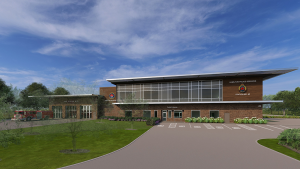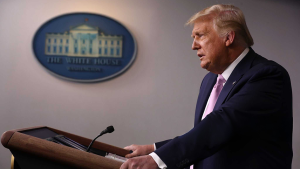It’s final.
The cost of the new Gordie Howe International Bridge connecting Windsor and Detroit will be $5.7 billion, including $3.8 billion in direct construction and $1.9 billion for future operation and maintenance. It is slated for completion in 2024.
The numbers were revealed Sept. 28 at an announcement marking the financial close of the deal between governments on both sides of the border and the consortium chosen to undertake construction, Bridging North America.
The bridge will be six-lanes and of a cable-stayed design, 2.5 kilometres in length with a clear span between towers of 853 metres.
Not just for motor vehicles, it will also have a multi-use path for cyclists and pedestrians.
Construction will get underway in October but preparatory work has been ongoing for three years in Windsor and got underway this summer in Detroit.
Dwight Duncan, chair of the Windsor-Detroit Bridge Authority (WDBA), the Canadian Crown agency overseeing the project, called the cost “tremendous value,” given the 125-year lifespan for the bridge.
He touted the public-private partnership model as saving $563 million, based on Deloitte analysis, compared to traditional construction procurement methods.
More specific job numbers were also released: 2,500 direct onsite jobs including subcontractors and seconded individuals with a spinoff regional impact of 7,500 jobs.
There are four components to the project — the bridge itself, the Canadian and U.S. ports of entry (POE), which will contain tolling and customs facilities, and the interchange connecting the Detroit port to Interstate 75.
The consortium partners, which have wide experience throughout the world in major infrastructure, including in North America with the $6.3-billion Reseau Express Metropolitain in Montreal, the US$4.9-billion Automated People Mover at LAX, and the $10.7-billion Site C dam in British Columbia, will be paid continuously on an “outcome based” schedule, Duncan said.
“Our partners now have certain obligations that they have to meet,” he said. “We have a number of tools at our disposal that if they don’t, they are in effect penalized.”
He said this method proved beneficial when constructing the now open 11-kilometre Herb Gray Parkway, connecting Highway 401 to the bridge site.
When defective girders were found “the contractor at the time had to replace them all at their cost,” he added.
Other project design elements for the Gordie Howe bridge include green roofs for Silver-rated LEED facility buildings, native species landscaping, public art, including stylized references to hockey, and “dramatic lighting” at night, WDBA spokeswoman Heather Grondin said.
Progress payments will be paid monthly based on scheduled work completed after verification by an independent technical analysis.
A payment will also be made at substantial completion of the bridge project, Grondin explained. Then, monthly payments will start for the 30-year operation and maintenance concession also held by Bridging North America.
Prior to the end of the concession the consortium must develop a plan “five years before handback” for maintenance of the bridge’s residual life, said Leslie Martin, WDBA executive vice-president for engineering and operations.
Significant construction will get underway “late October or early November” with a test pile for the main bridge pier on the U.S. side.
A $22 million major remediation contract for the main Canadian pier was completed in late August.
As well, investigative work has started on all pier locations and modifications to the U.S. seawall will also be done.
“The seawall has tiebacks that they have to relocate or reconfigure and start doing piling to create the area where foundation work will proceed,” Martin said.
The cable-stayed design was chosen over the suspension model for several reasons.
“The economics were certainly part of it,” said consortium spokesman and Dragados senior vice-president Tom Middlebrook. “There’s more redundancy in a cable-stayed bridge. In the case of a cable failure we can have more than one fail. In a major suspension bridge, if the primary cable goes that’s not good.”
Hiring for the project will be done through the consortium.
One-hundred people have already been hired with 315 to be on the job by Dec. 31.
There will be a specific workforce strategy to focus on how “we can engage local workers and contractors,” Grondin said.
At least $250 million in work on the Canadian side is to go to local contractors within 100 kilometres of Windsor.
Another aspect is to “engage and employ Indigenous people and contractor businesses,” she said. On the U.S. side there will be a focus on hiring Detroit workers and city businesses including “disadvantaged business enterprises.”
Since this is an international project the goal is to strike a 50-50 balance between Canadian and U.S. workers, each working on their sides, Duncan said. This would vary depending on construction phases. For example, there is no freeway interchange on the Canadian side and much of the preparatory work at the Windsor POE has been completed.
Bridging North America is led by ACS Infrastructure Canada subsidiaries ACS and Dragados, with partners Fluor and Aecon.











It’s actually a $10.7 billion Site C dam. Not $1.6 billion.
Hi Louise,
Thank you for catching that error!
Vince Versace
DCN & JOC national editor